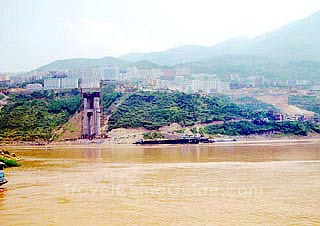Badong
 |
| Badong County along Yangtze River |
On the 2,000 miles’ territory, Tujia and Miao nationalities live a happy and elegant life, which makes the land a unique one with its minority flavor. Although a part of Bodong’s territory (including docks, roads, residences and some infrastructural facilities) has been merged into the Yangtze River because of the Three Gorges Dam Project, the economy of the county recovered quickly and is developing in its own right.
Natural Scenery and Local Products
With a history of 1,500 years, the country is endowed with numerous natural resources and scenery. Plants, such as gingko and cotton rose, and animals, such as the giant salamander and golden monkeys, grow or settle on this treasured land. The county is abundant with coal and iron reserves.
The vast land, pleasant climate and special soil provide advantageous conditions for the growth of some special local products. Fields for orange planting covers an area of about 9 square mile, producing over 10,000 tons of oranges each year. Among the oranges, autumn oranges have been exported to Japan, Russia and other countries. The tea here is also considered a speciality of Badong. Despite the quantity and quality, the Badong tea deserves appreciation. Moreover, there are garlic and konjac as well as all kinds of Chinese medical materials. Tremella, Jew’s-ear, persimmon, Chinese gooseberry and other local products also made great contributions to the development of Badong.
Additionally, picturesque scenery in Badong is worth a visit. The Shennong Stream with elegant landscape is well-known throughout the world. Gezi River Stone Forest is characterized by the quietness of the Three Gorges, the elegancy of Gulin and the strangeness of Zhangjiajie. Autumn Wind Pavilion (Qiufeng Ting) and White Cloud Pavilion (Baiyun Ting) are the simple and classic scenic spots.![]() Shennong Stream
Shennong Stream![]() Gezi River Stone Forest
Gezi River Stone Forest
Gezi River Stone Forest is famous as the Small Guilin of Three Gorges. Lying on a belt of river valley, it is 70 kilometers (about 37.8 mi) from Badong. Having the Karst land form, Gezi River Stone Forest is divided into four scenic areas: Stone Forest, Thousand-meter Stone Barrier (Qianmi Shiping), Jiaxiangzi and Nine Dragon Temple (Jiulongguan).
Gezi River Stone Forest covers 1,500 square meters (about 1,794 sq yd). In the scenic area, strange stones of various shapes are very beautiful. They are like generals, couples, mushrooms and other shapes. The most attractive scenery here is Couple Stone, Rhinoceros Cave, Heaven Directing Cave, and Lamb Cave.
Thousand-meter Stone Barrier is 1,500 meters (about 4,921 ft) long and over 100 meters (about 328 ft) high. As a book store, it stands along the river with four springs falling from the crest. Jiaxiangzi and Nine Dragon Hall lie between the Stone Barrier. On the right bank of the lower reach of Gezi River, there are two temples on the top of the 1,100 meters (about 3,609) high Chuanxinya. There is also a gorgeous Catholic church, which was built by a Belgian missionary in 1851, which lies on the southeastern bank of Gezi River.![]() Autumn Wind Pavilion
Autumn Wind Pavilion
First built by Kouzhun, a famous prime minister in the North Song Dynasty (960-1127), as he was the magistrate of Badong, Autumn Wind Pavilion has over 1,000 years history. It was at the pavilion that many literati left universally popular poems. Most of the poems described the beautiful scenery and their emotions at that time quoting the pavilion. Nowadays, Autumn Wind Pavilion is a must visit for tourists because the magnificence of the mountains and Yangtze River can be appreciated from the pavilion.
Tips:
Local Products: Chinese medicinal material, tea, gastrodia tuber and konjac.
Local Snacks: spiced dried bean curd, pickles, edible wild herbs and mutton noodles.